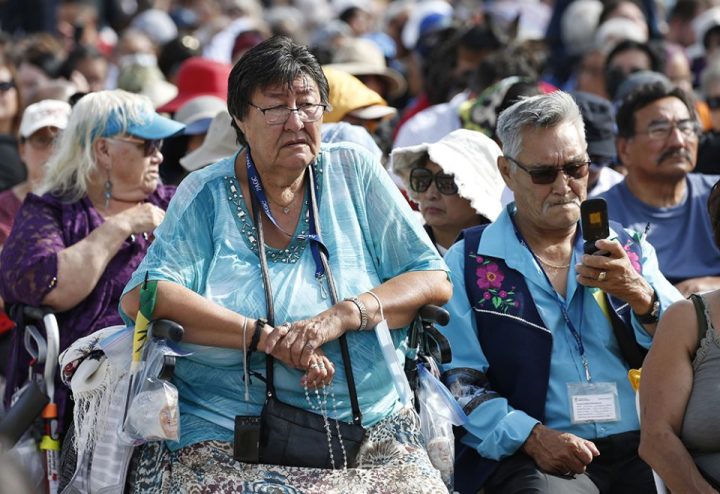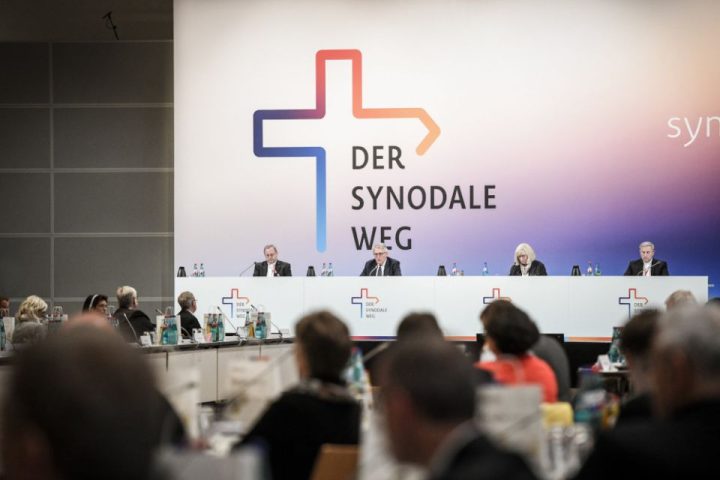At Thanksgiving, we give thanks for the gifts of the earth. Servant of God Nicholas Black Elk helps us see that the earth — and the Creator — gives thanks for us, too.
Those who did not know Black Elk personally might think that he had little to be thankful for. He was partially blind, suffered from tuberculosis, widowed twice and saw four young children and stepchildren die. Early economic success withered in the Great Depression like the dustbowl grass.
Add to that his experiences of the dead bodies he saw at Wounded Knee and the colonial oppression of the reservation system that continues even today and it is not hard to see why John Neihardt at the end of Black Elk Speaks could mistakenly characterize him as a « pitiful old man who has done nothing. »
Yet much of the world now knows Black Elk as his community does: a vibrant, proactive agent of healing who lived in hope and gratitude.
For Black Elk, Thanksgiving was one of the most important days of the year. So much so that his daughter, Lucy Looks Twice, remembered verbatim the prayer he said every Thanksgiving. Gratitude flowed out of his Lakota spirituality and merged with the Catholic Way, a way of praying that can inform our practice of Thanksgiving today.
Many Indigenous authors, including Potawatomi botanist Robin Wall Kimmerer in Braiding Sweetgrass, emphasize that gratitude is a daily practice in Indigenous cultures. For Kimmerer, a culture of gratitude is one of reciprocity, where « each person, human or no, is bound to every other in a reciprocal relationship. Just as all beings have a duty to me, I have a duty to them. » All « know that gifts will follow the circle of reciprocity and flow back to you again. »
‘May we give you thanks, now and always.’
—Black Elk
Black Elk gave us countless prayers of thanksgiving from the Lakota Way, such as this prayer in The Sacred Pipe for all our relatives in the natural world: « May we give you thanks, now and always, » Black Elk prayed. « May we be continually aware of this relationship which exists between the four-leggeds, the two-leggeds, and the winged. May we all rejoice and live in peace! »
For many Indigenous peoples, the practice of thanksgiving starts by thanking our relatives in the natural world, demonstrated by the Haudenosaunee Thanksgiving Address. The Haudenosaunee, who many people know as the Iroquois, use this beautiful litany to salute each part of the natural world.
« We are all thankful to our Mother, the Earth, » the address starts, « For she gives us all that we need for life. … It gives us joy that she continues to care for us as she has from the beginning of time. To our mother, we send greetings and thanks. »
Only after addressing our earthly relatives do the Haudenosaunee then turn to the Creator. Black Elk fleshes out why in his Thanksgiving prayer remembered by his daughter Lucy in Holy Man of the Oglala, demonstrating how to not only thank all living beings, but also to join with them to offer thanks to God.
« The nations of living things the world over — and we the two-leggeds, along with the children and smaller ones with them — come to you today [on Thanksgiving], » Black Elk prayed, « to express thanks. »
Black Elk could have been quoting the very last line of the Psalms: « Let everything that has breath give praise to the Lord! » (Psalm 150:6). For Black Elk and biblical tradition, humans are one voice among countless voices who join together to praise God.
Becoming part of a chorus of gratitude is a beautiful idea to sit with and grow into. Yet there is a challenging final step to this circular relationship of gratitude: Indigenous traditions also hold the belief that the land itself gives thanks — for us.
‘We are all thankful to our Mother, the Earth. For she gives us all that we need for life.’
—Haudenosaunee Thanksgiving Address
It is hard to believe humans can be recipients of gratitude from the Earth given the way we’ve treated her and how we often imagine ourselves as the only beings capable of spiritual agency. Yet the land not only gives thanks, Kimmerer argues in Braiding Sweetgrass, but also love, despite how we act.
« The land loves us with beans and tomatoes, with roasting ears and blackberries and birdsong. By a shower of gifts and a heavy rain of lessons. She provides for us and teaches us to provide for ourselves. That’s what good mothers do, » Kimmerer writes.
A healthy relationship requires a belief that you are worthy of love and can be a benefit to your beloved. « Knowing that you love the earth changes you, activates you to defend and protect and celebrate, » writes Kimmerer. « But when you feel that the earth loves you in return, the feeling transforms the relationship from a one-way street to a sacred bond, » she continues.
And God appreciates and loves us, too. For those steeped in a cheap « Sinners in the hands of an angry God » spirituality, this might seem idolatrous. But God is in our midst singing « joyfully because of you, as on festival days » (Zephaniah 3:17-8), as the NABRE translation on the USCCB website says. Other translations draw this out better: « He will rejoice over you with singing. »
Giving thanks, then, is a great circular motion: gratitude for the beings and gifts of the earth, gratitude with the beings of the earth for God, gratitude from the beings of the earth for humanity, gratitude from God for humanity — continually circulating yet focused and magnified at a ceremonial feast like Thanksgiving.
Advertisement
This circular relationship of gratitude is also highlighted in the ritual of the Catholic Mass.
I knew « eucharist » in Greek meant « an act of thanksgiving, » but it wasn’t until hearing Lakota elder Basil Brave Heart repeat it over and over in conversations and talks he’s given that it sank in. Mass is a dynamic relational event that’s bigger than just praising God. Through Mass, we give thanks to the Earth — who co-created with God on the third day in Genesis (Genesis 1:11-12) — and for the gifts of bread and wine. We thank our community for walking with us on our earthly pilgrimage. We thank God for our ancestors who helped give us life and faith, for our children and grandchildren and for their love, one of the most meaningful gifts many of us will ever receive.
Just as important as expressing gratitude is receiving it. Our ancestors thank us for listening to their call and following the path on which they lead us. Our community thanks us for the gifts that help it to flourish. Our children thank us for the endless love we give (maybe not today, but someday).
And God is thankful for us, singing over us in joy. « Keep us on this road, » Black Elk prayed in his Thanksgiving prayer, « I, my children, and my grandchildren shall walk — led like children in your hand. » I know that there are times that through holding my child’s hand, I receive the greater gift.
We bring our gifts to Mass. This Thanksgiving, maybe it’s time to imagine bringing a gift to the Earth. Not in opposition to or in replacement of the gifts we bring to Mass, but as an extension of the ritual, reciprocating the currents coursing through the universe from the Holy Trinity itself.
These currents help us believe that we have gifts for which the Earth can be thankful, and despite our massive failings, we are worthy of her love. And this love can help us be the kind of children we are called to be and that the Earth deserves. She, through and along with God, gives us life.



